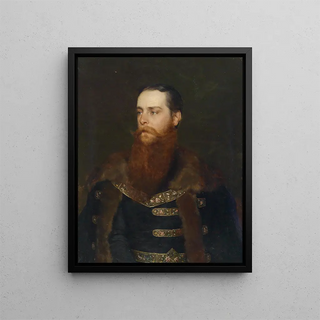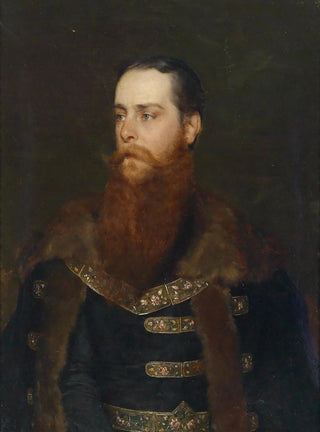Art print | Portrait of Count Arthur Berchtold - Eugen von Blaas


View from behind

Frame (optional)
Art print Portrait of Arthur Count Berchtold - Eugen von Blaas – Captivating introduction
The "Portrait of Arthur Count Berchtold" by Eugen von Blaas is a masterpiece that immerses the viewer in a universe where nobility and art intersect. This painting, emblematic of the late 19th century, captures not only the physical appearance of its subject but also his essence, character, and social status. Through rich colors and meticulous details, Blaas manages to create an atmosphere that is both intimate and majestic. Count Berchtold, a leading figure of high society, is depicted here with a dignity that transcends a simple portrait. This work, with its psychological depth and elegance, invites prolonged contemplation, where each brushstroke seems to tell a story.
Style and uniqueness of the work
Blaas's style is characterized by striking realism, combined with a romantic sensitivity unique to him. In this portrait, the artist uses a palette of warm colors and subtle play of light to emphasize the features of Count Berchtold. The texture of the clothing, finely rendered, demonstrates exceptional craftsmanship, while the background, slightly blurred, highlights the central figure. This approach allows the focus to be on the face of the count, whose penetrating gaze appears to follow the viewer, creating a palpable connection between the work and its observer. The composition, balanced and harmonious, reinforces the idea of power and refinement, characteristic of the nobility of the era. Every element of this portrait is thoughtfully considered, revealing Blaas's technical mastery and his ability to capture human essence.
The artist and his influence
Eugen von Blaas, an Austrian painter of the 19th century, established himself as one of the great masters of his time. Trained in the most prestigious art academies, he developed a unique style that combines tradition and innovation. His work is often associated with the depiction of aristocratic figures, and his talent for portraiture earned him international recognition. Blaas transcended the conventions of his era by infusing his portraits with a psychological dimension, allowing his subjects to come to life on the canvas. His influence extends

Matte finish

View from behind

Frame (optional)
Art print Portrait of Arthur Count Berchtold - Eugen von Blaas – Captivating introduction
The "Portrait of Arthur Count Berchtold" by Eugen von Blaas is a masterpiece that immerses the viewer in a universe where nobility and art intersect. This painting, emblematic of the late 19th century, captures not only the physical appearance of its subject but also his essence, character, and social status. Through rich colors and meticulous details, Blaas manages to create an atmosphere that is both intimate and majestic. Count Berchtold, a leading figure of high society, is depicted here with a dignity that transcends a simple portrait. This work, with its psychological depth and elegance, invites prolonged contemplation, where each brushstroke seems to tell a story.
Style and uniqueness of the work
Blaas's style is characterized by striking realism, combined with a romantic sensitivity unique to him. In this portrait, the artist uses a palette of warm colors and subtle play of light to emphasize the features of Count Berchtold. The texture of the clothing, finely rendered, demonstrates exceptional craftsmanship, while the background, slightly blurred, highlights the central figure. This approach allows the focus to be on the face of the count, whose penetrating gaze appears to follow the viewer, creating a palpable connection between the work and its observer. The composition, balanced and harmonious, reinforces the idea of power and refinement, characteristic of the nobility of the era. Every element of this portrait is thoughtfully considered, revealing Blaas's technical mastery and his ability to capture human essence.
The artist and his influence
Eugen von Blaas, an Austrian painter of the 19th century, established himself as one of the great masters of his time. Trained in the most prestigious art academies, he developed a unique style that combines tradition and innovation. His work is often associated with the depiction of aristocratic figures, and his talent for portraiture earned him international recognition. Blaas transcended the conventions of his era by infusing his portraits with a psychological dimension, allowing his subjects to come to life on the canvas. His influence extends






